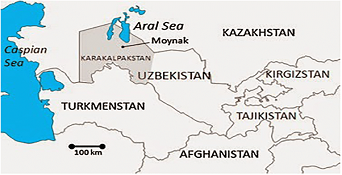Unrest in Karakalpakstan
Context
Eighteen people were killed and 243 wounded during unrest in Uzbekistan's autonomous province of Karakalpakstan which broke out over plans to curtail its autonomy.
Who are the Karakalpaks?
- The name Karakalpakstan is derived from the Karakalpak people, an ethnic minority group of around 2 million.
- Karakalpak translates to ‘black hat’, referring to their traditional headgear.
- The Karakalpaks consider themselves to be a distinct cultural group in Uzbekistan.
- Their Turkic language – Karakalpak – is closely related to Kazak and is one of the 7 languages of instruction in Uzbekistan’s public schools.
- Their separate language is a crucial aspect of their cultural identity.
- In their genealogical narrative, the Karakalpaks claim to share a common point of origin with the neighbouring Kazakhs, Uzbeks and Turkmen, but believe that over time they diverged from the others.
- This narrative marks the Karakalpaks as culturally separate from their neighbouring groups.

Background
- The Karakalpak people settled around the Amu Darya (a river that feeds into the Aral Sea) in the 18th century.
- By 1873, they partly came under Russian rule and by 1920 were completely incorporated into the Soviet Union.
- Their region, Karakalpakstan, was an autonomous area within the Russian Soviet Federative Socialist Republic (Russia during 1917-1922), before it was made a part of Uzbekistan as the Karakalpak Autonomous Socialist Republic (ASSR) in 1936.
- When Uzbekistan declared its independence from the Soviet Union in August 1991, Karakalpak ASSR was re-established as the Republic of Karakalpakstan in December of the same year.
- Karakalpakstan was formally recognized as an autonomous republic in Uzbekistan’s constitution of 1992, and has the right to secede from on the basis of a nation-wide referendum.

